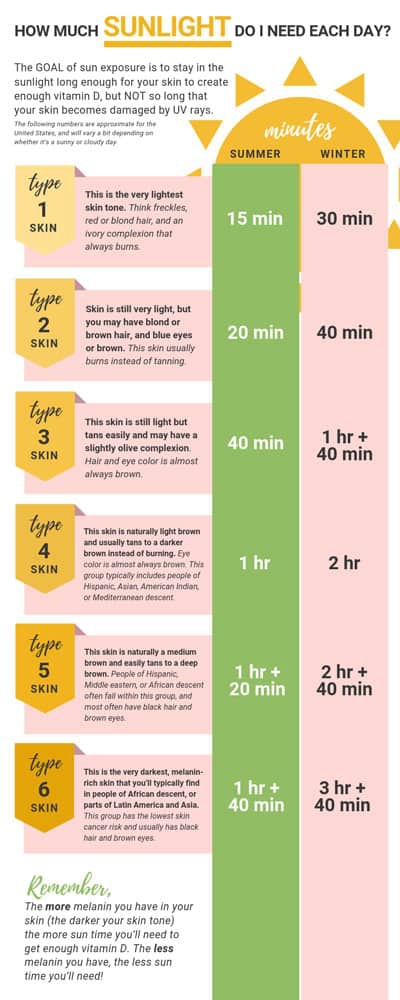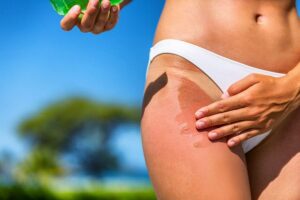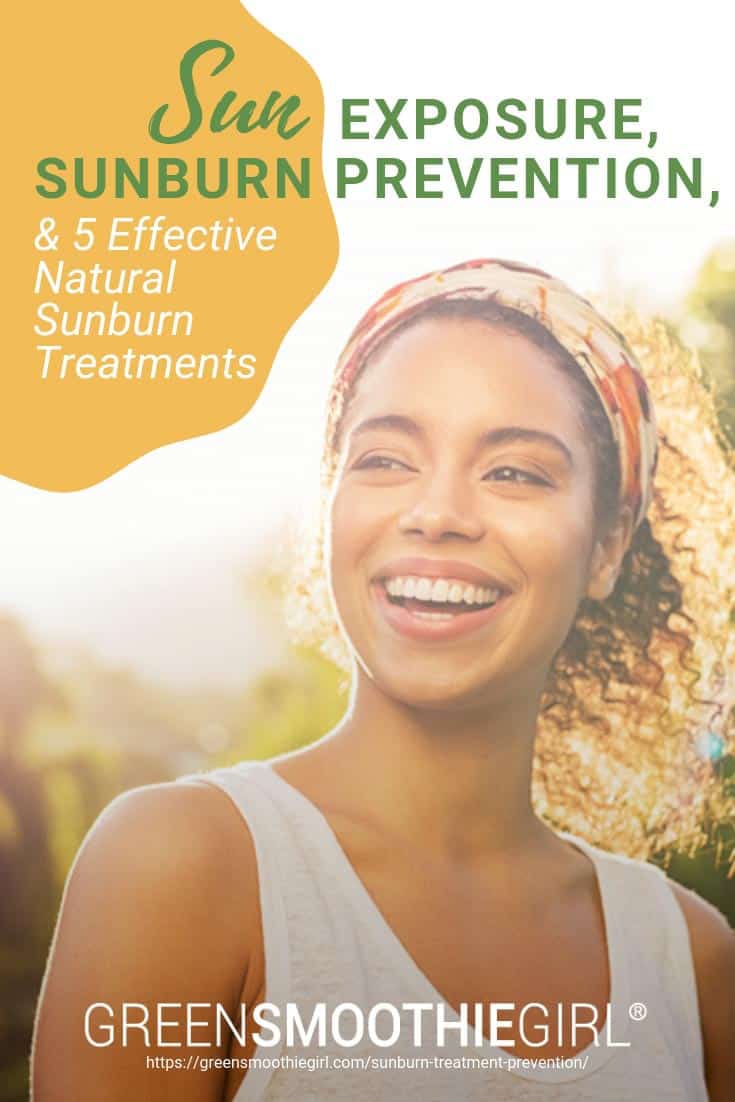The Healing Power of the Sun + 5 Effective Natural Sunburn Treatments

Ironically, most of us don’t know which way is up when it comes to the sun. And it’s no wonder when we get so many mixed messages about sun exposure and sunburn prevention.
Should you be wearing sunscreen at all times when you go outside? What about the risks of chemical sunscreens?
In this post:
- Is Sun Exposure Good for Your Skin?
- Sun Exposure and Skin Type
- How Much Sunlight Do I Need Each Day?
- What About Sunscreen?
- Foods That Can Help Prevent Sunburn
- Foods for Natural Sunburn Treatment
- The Bottom Line on Natural Sunburn Prevention and Sunburn Treatment
How much sun do you need, to get enough vitamin D? How can you prevent sunburns without chemical sunscreens? What natural sunburn treatments actually work?
Let’s talk skin type, sun exposure, sunscreen, and sunburns!
Is Sun Exposure Good for Your Skin?
First of all, let’s set the record straight. Your skin absolutely needs sun exposure, because that’s how your cells were made to absorb UV rays and synthesize vitamin D (which determines how well your body absorbs calcium, helps your muscles and nerves work properly, and even protects you from cancer).
Light from the sun is a nutrient in a very real way.1
Ever notice how just one dose of most vitamin D supplements is about 250% of your minimum daily requirements?
That’s because, unlike vitamin D from sunlight, manufactured vitamin D added to milk and supplements isn’t very bioavailable or readily absorbed by the human body. That’s one reason about 50% of us are deficient.1
So, yes. You NEED sun exposure most days of the year.
Exactly how much time you need to spend in the sun before you run the risk of skin damage will depend a little bit on your skin tone (more on that next!).
First, let’s talk about how much sunlight your skin actually needs. Then, we’ll dive into sunscreens, sunburn prevention, and sunburn treatment!
Sun Exposure and Skin Type
Exactly how much time you need to spend in the sun depends primarily on your skin type (or the baseline amount of melanin in your skin).
Melanin, or the pigment in your skin, acts as a natural shield to UV damage—but more melanin means that the skin absorbs vitamin D from UV rays more slowly.

When early humans migrated to Europe from Africa, many of them died from rickets (bone decomposition caused by low vitamin D absorption) because of the significantly reduced sun exposure.
That’s how some of us evolved to have naturally light skin with less melanin, which absorbed vitamin D more quickly as we made our homes away from the equator (and burned more quickly, too).
How Much Sunlight Do I Need Each Day?
The goal of sun exposure is to stay in the sunlight long enough for your skin to create enough vitamin D, but not so long that your skin becomes damaged by UV rays.
Sun exposure is like everything else (including water!): too much will hurt you, and not enough will hurt you, too.
Skin scientists call this healthy range of sunlight your Minimal Erythemal Dose (MED, or the amount of sun you can safely take in before damage will happen). And your MED2 depends on your geographical location, skin type (how much of that melanin you’ve got), and the time of year (in winter, you can safely spend more time in the sunlight).
[Related: How To Beat Winter Blues]
While you don’t need to stay in the sun for your full MED each day to absorb enough vitamin D (somewhere in the middle is a good rule of thumb), you should keep the following numbers in mind as a guide for when to seek shade, go indoors, put on clothes, or apply a natural sunscreen.
The following numbers are approximate for the United States and will vary a bit depending on whether it’s a sunny or cloudy day. (You can use this handy sunbathing calculator to find your magic number!)

Tip: After you’ve been in the sun, don’t shower for several hours if possible. Otherwise, you wash off the substance on your skin that your body converts to Vitamin D.
What About Sunscreen?
Most of us have been taught to think “the more, the better” when it comes to sunscreen use. And while it’s true that sunscreen can be beneficial in some cases (like a full day swimming at the beach), you should be very choosy about the type of sunscreen you use — and use sunscreen as a last resort.
If you spend long days outside and worry about sun exposure, better to wear clothing that covers your skin and keep in the shade when possible.
Why not just slather on the sunscreen? About that:
Sunscreen Risks You Should Know About
The unfortunate truth is that most sunscreens are filled with dangerous chemicals including oxybenzone, avobenzone, octisalate, octocrylene, homosalate, and octinoxate. These chemicals filter out UV radiation— while simultaneously mimicking thyroid and sex hormones.
And since sunscreen is specifically made with “penetration enhancers” that help skin absorb it rapidly, these chemicals enter our bodies quickly.

One study showed that sunscreen enters the bloodstream immediately—and stays there for 24 hours afterward.
Another study conducted by Swiss researchers found that 85% of breast milk samples contained chemicals found in sunscreen.3
Yet another study revealed that retinyl palmitate, a common ingredient in sunscreen, increases the growth rate of cancerous cells by more than 20%.4
What About Mineral Sunscreen?
Mineral sunscreens use a mineral barrier like zinc oxide or titanium oxide to screen UV rays. And if you must wear sunscreen, they’re a far safer option than the chemical soup you’ll find in most traditional sunscreens (especially spray-ons, which you’re also at risk for breathing in).
However, zinc oxide and titanium oxide aren’t benign substances, and research is ongoing to determine the risk of tiny zinc or titanium particles entering the bloodstream.5
Tip: Just because a product is labeled as a “mineral sunscreen,” you’ll still need to read labels to make sure it doesn’t contain some of the same toxic ingredients used in chemical sunscreens.
What Are the Best Brands of Sunscreen?
Wondering how your favorite brand of sunscreen stacks up?
My friend Katie Kimball of Kitchen Stewardship has also researched sunscreen ingredients and tested over 100 brands of sunscreen with her family. Check out her findings and her sunscreen reviews6 over on her blog.
Sunscreen Alternatives
Whenever possible, opt for a sunscreen alternative instead of slathering on the white stuff.
Screen UV rays with a canopy, hat, sunglasses, and clothing. Also do your best to stay out of the sun during peak hours at midday, when UV rays are the strongest.
You can also protect your skin from excessive UV rays with foods that help prevent sunburns (up next!).
Can Foods Help Prevent Sunburn?
Yes! Several fruits and vegetables have the potential to help protect skin from UV damage and prevent a painful sunburn.
Make them a regular part of your diet to keep your skin healthy and unscathed by the sun.
Fruits and Vegetables High in Beta Carotene and Antioxidants
Fruits and vegetables that are rich in beta carotene, like beets, carrots, sweet potatoes, and apricots, act as natural sunscreen.8
Carotenoids filter UV rays and act as an antioxidant to neutralize free radicals (uncharged, highly reactive molecules that result from damage and stress to the body, and can harm cells and organs).
A “Natural” Fake Tan?
The red and orange pigments in beets and carrots also color my skin slightly to mimic a tan!
Because I drink fresh-made juice and smoothies with carrots and beets and lots of other greens and veggie antioxidants, I don’t burn much anymore.
Try my Hot Pink Breakfast Smoothie Recipe for a yummy way to get carrots and beets—it’s my daily breakfast and GreenSmooothieGirl’s most popular recipe!
Fruits and Vegetables Rich in Lycopene
Some fruits and vegetables, like tomatoes, guavas, bell peppers, grapefruits, and watermelon, are high in a particular carotenoid, lycopene (and antioxidants too!)
Lycopene packs twice the SPF power of beta carotene and is considered to have an SPF of 38 when consumed regularly. In one study, people who ate 5 tbsp of tomato paste daily for 3 months9 enjoyed 25% more protection against sunburn!
Dark Chocolate
As if any of us needed an excuse to eat more chocolate, cacao can actually help decrease your risk of sunburn.
High-cacao content is key, so not any chocolate bar will do! The darker the better (think 70% cacao at least).
Cacao packs a heavy antioxidant punch, as well as containing lots of flavonoids (which help improve the texture of the skin).
One study showed that participants who consumed 20 grams of chocolate high in cacao for 12 weeks were twice as resilient to UV rays as study participants who consumed low-cacao chocolate.10
[Related: Is Chocolate Actually Healthy for You?]
Pomegranates
This superfood has been used by cultures around the world for its medicinal value.11
Pomegranate is rich in antioxidants and ellagic acid, which protects skin against UVA- and UVB-induced cell damage. Pomegranates are also anti-inflammatory.
Several studies have shown that eating pomegranates can significantly reduce the amount of UVB and UVA damage from the sun,12 as well as reducing signs of skin aging.
Green Tea: Inside and Out
Green tea is one of my favorite occasional drinks in hot weather!
This superfood is high in catechins, a polyphenol compound that helps protect against the sun’s harmful radiation because of its antioxidant and anti-inflammatory properties.
Green tea can also be effective in preventing sunburn when applied topically.
In one study, people who applied green tea to one portion of skin, and a placebo to a different portion of skin, then exposed the skin to the sun, saw that the tea-treated skin area had a 38% decrease in sunburn cells.13
You can actually make your own green tea sunscreen, by following a recipe like this one.14
Used green tea bags are good on the skin for sunburn relief, too! Simply let the tea bags steep in hot water for 3-5 minutes, then add ice to cool the water and place the tea bags directly on burned skin.
[Related: Should You Stop Using Tea Bags for Your Health?]
Plant-Based Remedies for Natural Sunburn Treatment
It’s almost inevitable that you’ll get some degree of sun damage or sunburn in any given year. When you do get the occasional angry red skin, treat it naturally with the following plant-based remedies:
White Vinegar
Vinegar is a good topical, non-steroidal, anti-inflammatory. It will kill sunburn pain for about 20 minutes.
[Related: What kind of skincare does Robyn use?]
Cucumber
Blend up a refrigerated cucumber and apply it to the skin for soothing relief for a burn, as well as itch relief.
You can also mix cucumber with glycerine for sun protection! Just peel and mash one large cucumber, strain the pulp through a cheesecloth to extract the liquid, then mix the liquid with about a tablespoon of glycerine and apply liberally to the skin.
Turmeric
Turmeric is a natural antioxidant and anti-inflammatory to boot!
Studies have shown that it’s as effective as many over-the-counter NSAIDs (like Aleve) at reducing inflammation.15
Take organic curcumin (the active ingredient in turmeric) to help reduce pain and inflammation from a burn.
Fresh Aloe Vera
I love to slather fresh aloe vera on skin that’s had too much sun.
Even if you don’t have a green thumb, I’d recommending keeping an aloe plant in your house. They are succulents and hard to kill. I’ve had mine for over 25 years. In fact, I’ve had my aloe vera plant longer than I’ve had my four children, all now young adults.
Every time I burn my finger in the kitchen or get a sunburn, I cut off a stem and slice it in half to put on the burn. It cools, relieves pain, and helps avoid bubbling, blistering, and peeling.

Oatmeal
Oatmeal soothes a sunburn16 quickly! You can grind it up and put it in the bathtub, or boil it and make a paste for your inflamed skin.
Oatmeal has antioxidant properties, as well as being high in beta-glucan (which soothes skin and acts as an anti-inflammatory).
[Related: Oats: A Surprisingly Unique and Powerful Food for Gut Health and Preventing Disease]
The Bottom Line on Natural Sunburn Prevention and Sunburn Treatment
Most of us grew up thinking that the sun was the enemy—and that sunscreen was our best friend. Unfortunately, like many perceptions about health and nutrition in society, that’s not quite the truth.
Sunlight is a nutrient, and we each need sunlight daily to produce enough vitamin D. How much sunlight you’ll need to get enough vitamin D without risking a burn depends on your skin type, the time of year, where you live, and the strength of the sun that day.
In situations of prolonged sun exposure, you can reduce your risk of a burn by eating foods rich in antioxidants and natural sun blockers. When you must use sunscreen, opt for a mineral sunscreen instead of a chemical sunscreen, most of which are filled with harmful chemicals that have been shown to enter the bloodstream quickly, mimic hormones, and even cause cancer.
And if your skin does burn, use a natural sunburn treatment that will nourish your skin and relieve pain without chemicals.
Read Next: Toxic Cosmetic Ingredients to Avoid \ 9 Healthy Summer Snacks

Disclosure: This post may contain affiliate links that help support the GSG mission without costing you extra. I recommend only companies and products that I use myself.

Resources
- Nair R, Maseeh A. Vitamin D: The "sunshine" vitamin. J Pharmacol Pharmacother. 2012;3(2):118–126. doi:10.4103/0976-500X.95506
- Webb AR, Kazantzidis A, Kift RC, Farrar MD, Wilkinson J, Rhodes LE. Colour Counts: Sunlight and Skin Type as Drivers of Vitamin D Deficiency at UK Latitudes. Nutrients. 2018;10(4):457. Published 2018 Apr 7. doi:10.3390/nu10040457
- Schlumpf M, Durrer S, Faass O, Ehnes C, Fuetsch M, Gaille C, Henseler M, Hofkamp L, Maerkel K, Reolon S, Timms B, Tresguerres JA, Lichtensteiger W. Developmental toxicity of UV filters and environmental exposure: a review. Int J Androl 2008;31:144-51. doi: 10.1111/j.1365-2605.2007.00856.x
- Mei N, Xia Q, Chen L, Moore MM, Fu PP, Chen T. Photomutagenicity of retinyl palmitate by ultraviolet a irradiation in mouse lymphoma cells. Toxicol Sci. 2005;88(1):142–149. doi:10.1093/toxsci/kfi291
- Kim K.B., Kim Y.W., Lim S.K., Roh T.H., Bang D.Y., Choi S.M., Lim D.S., Kim Y.J., Baek S.H., Kim M.K. Risk assessment of zinc oxide, a cosmetic ingredient used as a UV filter of sunscreens. J. Tox. Environ. Health-Part B-Critical Rev. 2017;20:155–182. doi: 10.1080/10937404.2017.1290516.
- Kimball, Katie. “Natural Sunscreen Review: Over 100 Mineral Sunscreens Tested By One Family.” Kitchen Stewardship, accessed May 17, 2019.
- Environmental Working Group, Guide to Sunscreens, accessed May 15, 2019.
- “Sweet Potatoes, the Natural Sunscreen,” ncsweetpotatoes.com, accessed May 14, 2019.
- Stahl W, Heinrich U, Wiseman S, Eichler O, Sies H, Tronnier H. Dietary tomato paste protects against ultraviolet light-induced erythema in humans. J Nutr. 2001 May;131((5)):1449–51
- Williams S, Tamburic S, Lally C. J. Eating chocolate can significantly protect the skin from UV light. Cosmet Dermatol. (2009) 8:169–73. 10.1111/j.1473-2165.2009.00448.x
- Longtin R. The pomegranate: nature's power fruit? J. Natl. Cancer Inst. 2003;95(5):346–348.
- Afaq F., Malik A., Syed D., Maes D., Matsui M. S., Mukhtar H. Pomegranate fruit extract modulates UV-B-mediated phosphorylation of mitogen-activated protein kinases and activation of nuclear factor kappa B in normal human epidermal keratinocytes paragraph sign. Photochemistry and Photobiology. 2005;81(1):38–45. doi: 10.1562/2004-08-06-RA-264.1.
- Mnich C.D., Hoek K.S., Virkki L.V., Farkas A., Dudli C., Laine E., Urosevic M., Dummer R. Green tea extract reduces induction of p53 and apoptosis in UVB-irradiated human skin independent of transcriptional controls. Exp. Dermatol. 2009;18:69–77.
- Gerber, Stephanie. “Green Tea Infused Homemade Sunscreen,” Hello Glow, May 8, 2017.
- Takada Y, Bhardwaj A, Potdar P, Aggarwal BB. Nonsteroidal anti-inflammatory agents differ in their ability to suppress NF-kappaB activation, inhibition of expression of cyclooxygenase-2 and cyclin D1, and abrogation of tumor cell proliferation. Oncogene (2004) 23:9247–58. 10.1038/sj.onc.1208169
- Kurtz ES, Wallo W. Colloidal oatmeal: history, chemistry and clinical properties. J. Drugs Dermatol. 2007;6:167–170.
Posted in: Health Concerns, Lifestyle, Natural Products, Natural Remedies, Preventive Care, Supplements














